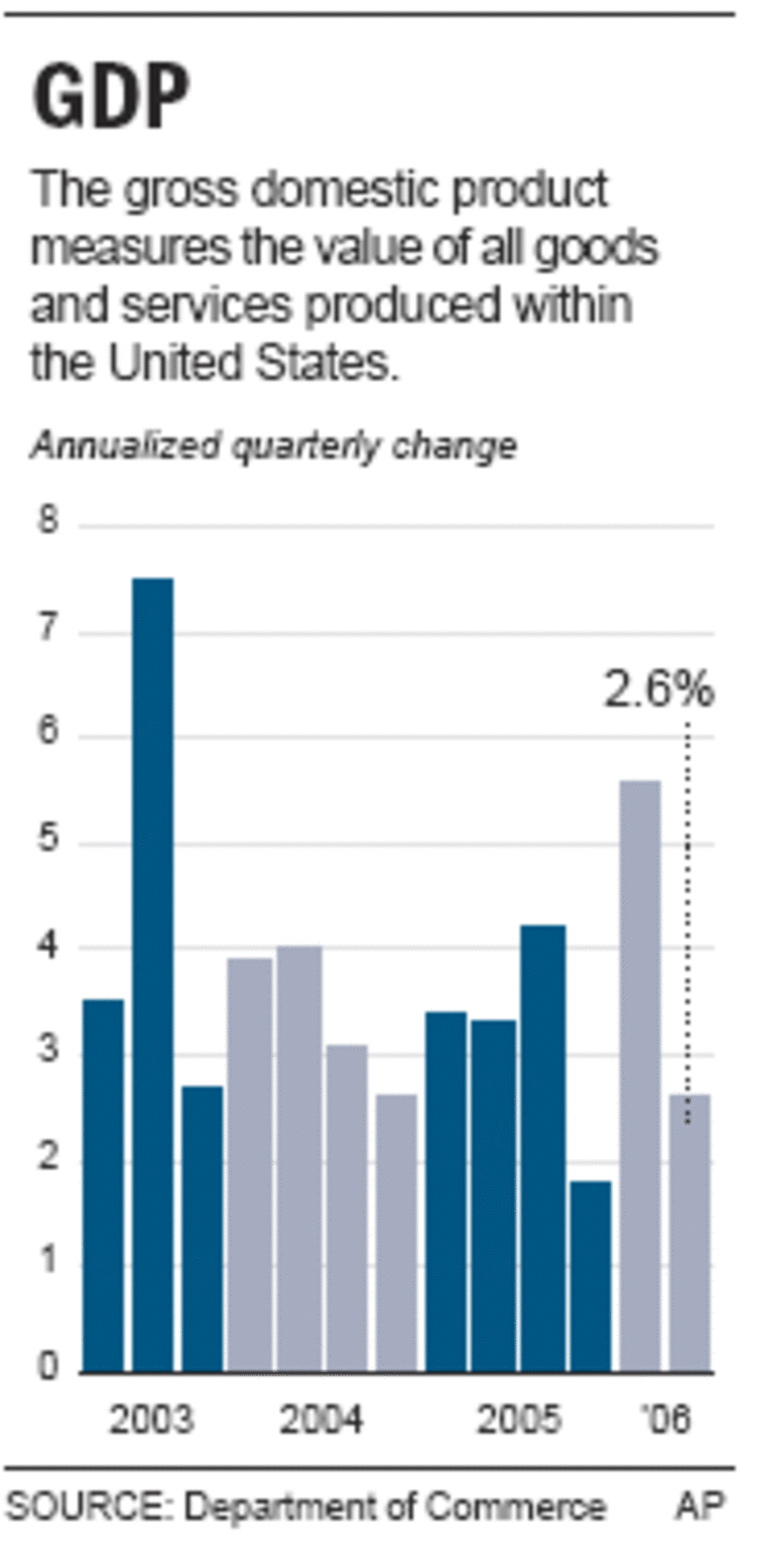The economy has a heavy burden on its shoulders: the end of the housing boom.
A sluggish growth spell is expected to continue past Election Day in November. For now, though, economists believe a recession can be avoided. Much will hinge on the extent to which the housing market loses ground in the months ahead and how consumers and businesses react.
Economic growth clocked in at an annual rate of just 2.6 percent from April through June, the Commerce Department said Thursday. That was even weaker than the 2.9 percent pace estimated a month ago for the gross domestic product and was the worst showing since the final three months of 2005, when the economy was reeling from the Gulf Coast hurricanes.
“I’m preparing people to get ready for a gut check. Growth is going to be so sluggish that you are going to hear a lot of talk about a recession coming, but, ultimately, I don’t think that is going to be the case,” said Ken Mayland, president of ClearView Economics.
Weakness in the housing sector, which had record sales for five years running, was especially felt in the spring.
Investment in home building plunged at an annualized rate of 11.1 percent, the most in 11 years. The housing slowdown is rippling through the economy, crimping spending and investment by consumers and businesses.

The second quarter’s performance shows just how much momentum the economy has lost since the winter. From January through March, the economy had grown at a brisk 5.6 percent pace, the fastest in 2½ years.
The economy has shifted into a slower gear because of several factors: the cooler housing market, the toll of once-surging energy prices and the impact of the Federal Reserve’s two-year string of interest rate increases.
Growth is expected to stay subdued through the end of the year.
The National Association for Business Economics is forecasting that the economy will expand at a 2.6 percent rate in both the June-through-September and October-through-December periods.
“That is certainly not roaring but isn’t so bad considering how much housing is pulling us down. I still think it is consistent with a soft landing for the economy,” said Carl Tannenbaum, chief economist at LaSalle Bank.
Economists, however, are not willing to rule out the possibility of a recession. One of the biggest wild cards is the magnitude of the housing slowdown.
Edward Lazear, chairman of the White House Council of Economic Advisers, told Congress on Thursday that economic growth from July through September will be “significantly slower” than it was over the first six months of the year.
“It appears that the housing slowdown will be a significant drag on third-quarter growth,” Lazear said.
On Wall Street, though, the Dow Jones industrial average briefly traded above its record high close of 11,722.98, set on Jan. 14, 2000, as investors felt better about the economy’s prospects to make a safe landing. By day’s end, the Dow gained 29.21 points to close at 11,718.45.
With the elections weeks away, people’s perception of the economy and their own financial situation may influence how they vote.
President Bush’s approval rating on the economy is at 39 percent, according to an AP-Ipsos poll. That is near his lowest level.
Bush and his fellow Republicans believe people are mostly better off with the GOP in control in Washington. Democrats disagree.
Consumer spending, which accounts for a big chunk of economic activity, rose at a 2.6 percent pace in the spring, a big pullback compared with the 4.8 percent mark from January through March. With house prices cooling, people cannot rely on extracting cash from their homes to support their spending.
Business investment in equipment and software dropped at a rate of 1.4 percent in the spring, a backslide from the stellar 15.6 percent growth rate in such investment in the first quarter.
Companies’ profits also lost ground. One measure of after-tax profits showed profits rose by just 0.3 percent, down from a 14.8 percent increase in the first quarter.
An inflation gauge tied to the GDP report showed that core prices — excluding food and energy — advanced at a rate of 2.7 percent in the second quarter. That compares with the first quarter’s 2.1 percent pace and shows inflation still is hovering outside the Fed’s comfort zone.
More recently, though, there have been signs that inflationary pressures are easing as energy prices have calmed.
After surging past $3 a gallon in the summer, gasoline prices are now averaging about $2.38 a gallon.
With the economy slowing and energy prices easing, the Fed last week held interest rates steady for the second meeting in a row. Many economists predict the Fed will stay on the sidelines for the rest of the year.
The Labor Department, meanwhile, reported that fewer people signed up for unemployment benefits last week. Jobless claims dropped by 6,000 to 316,000.
Economists are hopeful that a decent jobs market and retreating energy prices will help cushion the cooler housing market.